On Saturday, China commissioned its first 10,000-ton class maritime patrol vessel – “Haixun 09”. It would be just another coast guard ship, until you notice that it is not only the largest civilian boat, but also is equipped with the most advanced technologies, including BeiDou Navigation Satellite System , China’s answer to the U.S.-owned GPS navigation system.
The homegrown Chinese navigation network, completed in June 2020 and was designed to rival the GPS run by the U.S. Air Force, is said to be more powerful – and risky – because it is a two-way communication system. Formally initiated in 1994, the BeiDou project has raised serious security concerns as it can track users and even used in cyberattacks.
Beijing was forced to build its own version of GPS after it realized that its military could easily be brought down. During the Taiwan Strait Crisis in 1996, China fired three missiles to locations on the Taiwan Strait as a warning. Embarrassingly, while the first missile hit its intended target, the People’s Liberation Army (PLA) lost track of the other two.
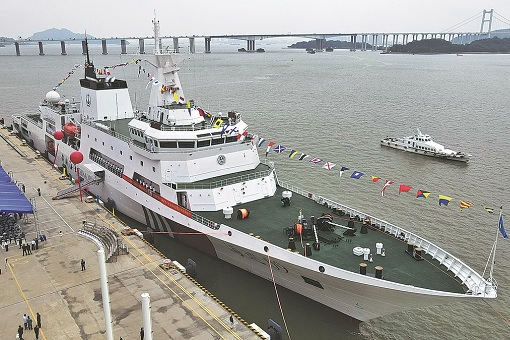
China later suspected that the U.S. had cut off the GPS signal in the region that the Chinese depended upon for missile tracking. It was the biggest loophole to cripple China’s missile system. Over 25 years later, China not only has its own GPS system, but has overtaken its U.S. rival in size. There were 35 BeiDou satellites in operation (as of last June), compared with 31 for GPS.
But BeiDou was also designed so that the navigation system could support domestic products and services worth 1 trillion Yuan (US$156 billion) by 2025. In the case of “Haixun 09”, it seems the deployment of the largest patrol vessel is to support and strengthen China’s claims in the South China Sea. The 10,000-ton ship can certainly deliver strategic resources in the region.
Built by Huangpu Wenchong Shipbuilding, the latest ship has a total length of 165 meters, a width of 20.6 meters, a depth of 9.5 meters and a full displacement of about 13,000 tons. Prior to Haixun 09, China’s largest ocean patrol ship had a displacement of about 5,000 tons, meaning the new ship is more than twice the weight of the existing sea patrol vessel.
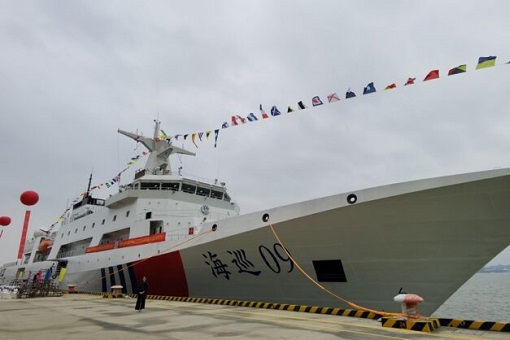
Interestingly, it was only in February this year that Haixun 06, a 5,000-ton maritime patrol rescue vessel – China’s largest – was unveiled. It has a total length of 128.6 meters, a width of 16 meters and a depth of 7.9 meters. Capable to navigate around 10,000 nautical miles (18,520 kilometres), Haixun 06 could patrol the sea for 60 days without the need to re-supply.
In comparison, the latest Haixun 09 could survive for 90 days without being resupplied with fuel and food. It has a maximum speed of more than 25 knots (about 47 kilometres per hour) and a range of at least 18,520 kilometres. In addition to BeiDou navigation system to monitor and provide early warnings, the 10,000-ton giant has a helicopter landing pad and a data center.
In another perspective, the sea route from Hong Kong to Port of Kuantan, Malaysia, is only 2,665-km. At 25 knots, Haixun 09 could reach Kuantan from Hong Kong in 3 days, and repeat the same route 6 times without refuelling or restocking. In fact, it could make a full trip from Hong Kong to Port of Sydney, Australia, before going back – with some extra fuel left.
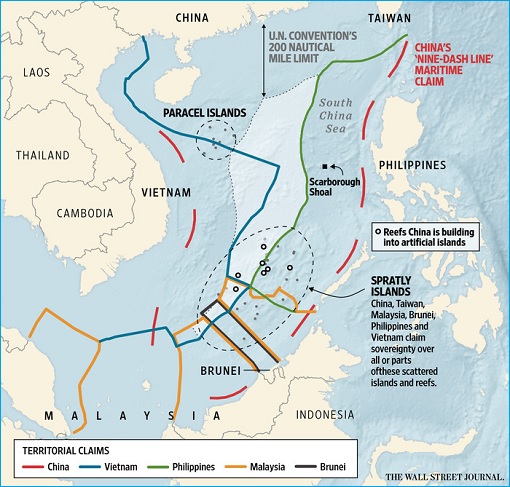
Clearly, the maritime patrol vessel is an incredible intimidating machine, deliberately built and deployed to flex muscles in South China Sea. A typical patrol boat is around 30 metres in length, more than 5 times smaller than the Chinese Haixun 09, which is operated by the CMSA’s (China Maritime Safety Administration) branch in Guangdong province in the south-east of the country.
Beijing said the new vessel will perform long-range patrols and SAR (search and rescue) support to help safeguard maritime traffic. It would also act as a “mobile law enforcement” platform for marine patrols – suggesting that the new asset will be used to help China assert its control in the region. Its secondary duties are maritime pollution prevention and firefighting.
Curiously, Beijing announced a new rule in August that all foreign ships entering the areas of the South China Sea it claims must register their details with the Chinese maritime authorities. Cao Desheng, director of the Maritime Safety Administration at the Ministry of Transport, said Haixun 09 represents the Chinese dream to sail the deep seas and demonstrate the country’s maritime abilities.
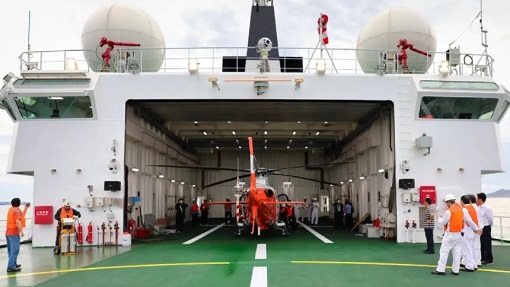
In April, just two months after China launched its 5,000-ton maritime patrol Haixun 06, Taiwan retaliated by commissioning its own 5,000-ton patrol vessel Chiayi, the island’s largest coastguard. More importantly, the Taiwanese ship can be converted into a frigate warship. Therefore, it’s absolutely possible that Haixun 09, if not Haixun 06, could also be converted to a warship.
In fact, Haixun 09 could be deliberately designed to mask itself as a civilian patrol ship, but with characteristic of a warship. China’s most advanced Type 055 guided missile destroyer has a displacement of 12,000 tons and a maximum speed of 30 knots. The U.S. military calls 055 a “cruiser” rather than a “destroyer” largely because its displacement exceeds the US “Ticonderoga” class of guided-missile cruiser (9,800 tons).
By quickly installing radar, missile launchers and combat command equipments, Haixun 09 could easily be converted to a battleship. Both Chinese Type 055 destroyer and Haixun actually feature slab-like flat portions along their hulls. Called “shouldering”, the purpose is to muscle into a rival ship, such as rival U.S. Navy vessels, forcing it to change course in order to avoid heavy damage.
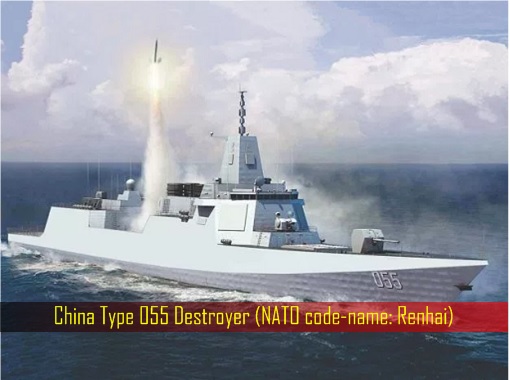
Hence, sending a coast-guard ship rather than a warship to do a shouldering ramming (some argue it’s a bullying tactic) is indeed a clever trick to force an enemy warship to pull back, lest an American warship wants to be seen as bullying a so-called Chinese maritime patrol ship. The U.S. has only gray warships in South China Sea, and not a single white patrol ship.
Actually, the Chinese Navy learns the shouldering tactics from the Russians. In February 1988, two different Soviet frigates separately bumped the U.S. Navy destroyer USS Caron and “Ticonderoga” class cruiser USS Yorktown in the Black Sea. There was minor damage, but the wrestling match at the sea was enough to trigger heated war of words.
Other Articles That May Interest You …
- Warning To The U.S. And Taiwan – Here’s Why China Sent Record 56 Warplanes Into Taiwan, Raising Fears Of War
- President Xi Warns China Will Never Be Bullied – The U.S. Not Impressed China Is Building 120 Nuclear Missile Silos
- Economic Destabilization – How China Prepares For American & Japanese Military Interference In Taiwan Conflict
- China Suddenly Banned Taiwanese Pineapples – And Taiwan Says The Political Retaliation Is Unfair & Unfriendly
- Warning To The U.S. – China Fires Nuclear-Capable “Aircraft-Carrier Killer” Ballistic Missiles In South China Sea
- Leaked Proposal For “Project XX6” – China Plans To Build A New Type Of Assault Aircraft Carrier
- China Tests Anti-Ship Ballistic Missiles In South China Sea – Here’s Why The U.S. Is Extremely Upset
- From Trade War To Political Kidnapping – Two Canadians Held “Hostage” As China Retaliates
- Chinese Flag Raised At Sri Lanka Port Raises Concern Of China Secret Naval Base
- Watch Out US, Japan, India – China Launches Asia’s Biggest Type 055 Destroyer

|
|
October 26th, 2021 by financetwitter
|


|

|

|

|

|

|




























Comments
Add your comment now.
Leave a Reply